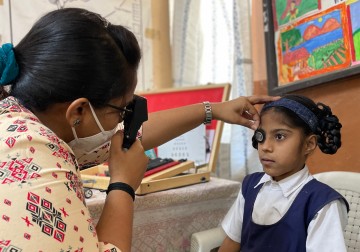In a new study from LVPEI, Winston Prakash, Dr. Rohit Khanna, Dr. Srinivas Marmamula, and Dr. Jill Keefe evaluate the effective refractive error coverage and spectacle coverage among schoolchildren in Telangana.
Vision is crucial for schooling—play, reading books, homework, or writing exams. Poor eyesight, often due to refractive errors (RE) like myopia, can jeopardize a child’s academic and career prospects. Lack of adequate exposure to sunlight and an excess of near work (reading, screen time) increases the risk of RE. Reports from around the world are raising the alarm on increasing myopia and RE in school-going children. RE can be effectively managed using spectacles. But for many children, their refractive error remains undetected, uncorrected as they lack spectacles, or is under-corrected as they wear spectacles with incorrect refractive power.
Effective refractive error coverage (e-REC) is a measure to assess the coverage of adequate refractive correction (spectacles, contact lenses, etc.) for those who need it in a population. It estimates the proportion of people who have received refractive correction versus people who never received any refractive correction (unmet need) and those who have spectacles, but with incorrect RE (under-met need). School-based refractive error screening programs, such as LVPEI’s I-SCREEN program, are an efficient means of evaluating RE and e-REC among children on a large scale. One of the World Health Organization’s (WHO) ‘2030 global eye health’ targets are to increase the e-REC by 40% points by the year 2030. Therefore, it is essential to calculate the baseline e-REC to understand the status based on which the future school refractive error programs could be planned to achieve the 2030 global eye health target.
In a new study published in the journal Eye, Winston Prakash, Dr. Rohit Khanna, Dr. Srinivas Marmamula, and Dr. Jill Keefe from LVPEI evaluate the prevalence of RE, e-REC, and spectacle coverage among schoolchildren in the south Indian state of Telangana. Vision screenings were conducted in 354 schools across four districts in Telangana, over a four-year period. A total of 774,184 schoolchildren (boys: 51.5%) aged 4-15 years were screened for this study using a tumbling ‘E’ visual acuity chart. Children with spectacles were screened with their glasses on. Children with vision and other eye problems were referred to a nearby LVPEI vision center for new or a change in spectacle prescription, or to a secondary center for more serious issues.
The overall prevalence of uncorrected refractive error (URE) in the study population was 1.44%, of which, myopia was 96% (1.38% prevalence). Urban areas like Hyderabad had a higher prevalence of URE (2.89%). The study also identified specific demographics who were at higher risk of myopia. Older schoolchildren (11–15 years) were 17-times more vulnerable than 4–5-year-olds. The risk was also higher in urban schoolchildren (3 times higher than children in the tribal areas), among girls (1.3 times higher than boys), and in children with disabilities (2.6 times higher). The overall e-REC was 56.97% and the spectacle coverage was 62.83%. The e-REC was higher in older schoolchildren (ranging to 69%) and boys (8%). E-REC was 10% lower among children in the tribal areas. These percentages flag a key area for policy and program implementation in Telangana—adequate RE coverage and correction.
‘The results of this study indicate the need for a 43% increase in e-REC in this region,’ notes Winston Prakash, a research optometrist at LVPEI and the first author on this paper. ‘In addition, there is also need for increasing spectacle coverage among this population by 38%.’
Citation
Prakash, W. D., Marmamula, S., Keeffe, J., & Khanna, R. C. (2024). Effective refractive error coverage and spectacle coverage among school children in Telangana, South India. Eye (London, England). Advance online publication. https://doi.org/10.1038/s41433-024-02986-6
Photo credit: school screening, by Winston Prakash.



